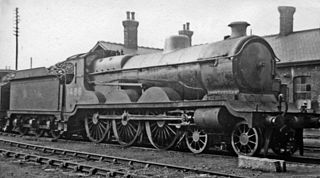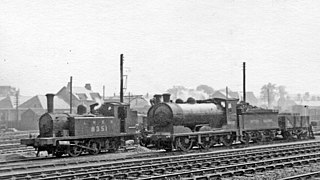
The Great Central Railway in England was formed when the Manchester, Sheffield and Lincolnshire Railway changed its name in 1897, anticipating the opening in 1899 of its London Extension. On 1 January 1923, the company was grouped into the London and North Eastern Railway.
John George Robinson CBE, was an English railway engineer, and was chief mechanical engineer of the Great Central Railway from 1900 to 1922.
The London and North Eastern Railway (LNER) produced several classes of locomotive, mostly to the designs of Nigel Gresley, characterised by a three-cylinder layout with a parallel boiler and round-topped firebox. It produced the most famous locomotive of its day, 4468 'Mallard', the holder of the world steam locomotive speed record. It also built the world-famous 4472 'Flying Scotsman'. However, its locomotive inheritance was much greater than just the 'A4 Class', it also produced highly successful mixed-traffic and freight designs.

The Great Central Railway (GCR) Class 8K 2-8-0 is a class of steam locomotive designed for heavy freight. Introduced in 1911, and designed by John G. Robinson, 126 were built for the GCR prior to the First World War. Including wartime construction for the British Army ROD and the post-war GCR Class 8M, the class and its derivatives totalled 666 locomotives.

The North British Railway (NBR) G Class is a class of 0-4-0ST steam locomotive designed for shunting. Some locomotives were equipped with small wooden tenders to carry extra coal. They were introduced in 1882 and thirty-eight entered service on the NBR between 1882 and 1899. Like most 0-4-0 tanks of the period it has outside cylinders and inside slide valves driven by Stephenson valve gear. The rival Caledonian Railway had the same number (38) of identical locomotives in service. The nickname "Pug" was used on the NBR.

The Great Central Railway Class 9N, classified A5 by the LNER, was a class of 4-6-2 tank locomotives designed by John G. Robinson for suburban passenger services. They were fitted with superheaters, piston valves and Stephenson valve gear.

The Great Central Railway (GCR) Class 9F was a class of 0-6-2T steam locomotive built between 1891 and 1901. From 1923 the locomotives were redesignated Class N5.

The NER Class X was a class of 4-8-0T tank locomotive designed by Wilson Worsdell for the North Eastern Railway. They were intended for use as powerful shunting engines to arrange and move coal wagons for loading into ships. In total 15 were built, 10 by the NER between 1909 and 1910, and a further five in 1925 by the London and North Eastern Railway (LNER). They had three cylinders with divided drive: the inside cylinder driving the leading axle, the outside cylinders driving the centre.

Gorton Locomotive Works, known locally as Gorton Tank, was in West Gorton in Manchester, England and was completed in 1848 by the Sheffield, Ashton-under-Lyne and Manchester Railway.

The GCR Class 1B was a class of 2-6-4T (tank) locomotives on the Great Central Railway. They were notable as the first locomotives of the 2-6-4T wheel arrangement to be used by a British standard-gauge railway; there had been two narrow-gauge examples on the Leek & Manifold Valley Light Railway since 1904.
The LD&ECR Class D was a class of nine 0-6-4T steam locomotives supplied to the Lancashire, Derbyshire and East Coast Railway in 1904 and 1906 by Kitson & Co. of Leeds. They later became the property of the Great Central Railway and finally the London and North Eastern Railway, upon which they were known as Class M1.
GCR Classes 8D and 8E were two pairs of three-cylinder compound steam locomotives of the 4-4-2 wheel arrangement built in 1905 and 1906 for the Great Central Railway.

The Great Central Railway 9K and 9L classes were two related classes of 4-4-2T Atlantic steam locomotives. They were both intended for suburban passenger services. After the 1923 Grouping, they served the LNER as classes C13 and C14.

The GCR Class 9Q, classified B7 by the LNER, was a class of 4-6-0 mixed traffic locomotives designed by John G. Robinson for fast goods, relief passenger and excursion services on the Great Central Railway. They were a smaller wheeled version of Robinson's earlier Class 9P "Lord Faringdon" express passenger class.

The GCR Class 5A was a class of seven 0-6-0T steams designed by John G. Robinson for work in docks operated by the Great Central Railway. They passed to the London and North Eastern Railway at the grouping in 1923 and received the LNER classification J63.

The GCR Classes 9D, 9H and 9M were a class of 124 0-6-0 Steam locomotives designed by Harry Pollitt for freight work on the Manchester, Sheffield and Lincolnshire Railway (MS&LR) later renamed Great Central Railway (GCR).

The GCR Class 2 steam locomotive was derived from a Kitson (Leeds) built/Thomas Parker designed prototype 4-4-0 locomotive No. 561, exhibited in Manchester in 1887. The design lead to the production of a series of express steam locomotives built between 1890 and 1894 for use on the Manchester, Sheffield and Lincolnshire Railway, later the Great Central Railway. The last batch of six, built 1894, had larger bearings for the coupled wheels, coil springs for the driving axle and was classified 2A.

The Great Central Railway (GCR) Class 9A was a class of 0-6-2T steam locomotive built between 1889 and 1892. From 1923 the locomotives were redesignated Class N4.

The GCR Class 8F was a class of ten 4-6-0 locomotives built for the Great Central Railway in 1906 by Beyer, Peacock and Company to the design of John G. Robinson for working fast goods and fish trains. They passed to the London and North Eastern Railway at the 1923 grouping and received the classification 'B4'.

The NBR F Class was a class of 0-6-0 tank locomotives, designed by William P. Reid on the North British Railway. They were used for dockyard shunting duties.
This page is based on this
Wikipedia article Text is available under the
CC BY-SA 4.0 license; additional terms may apply.
Images, videos and audio are available under their respective licenses.
















